Abstract
John Hunter suggested that the body's responses to injury were defensive and had survival value. Now, many years later, we are still uncertain about this. Although our appreciation of the endocrine and metabolic responses to injury, both physical and bacterial, has increased enormously our knowledge of these events, particularly at a molecular level, is still very incomplete. Patterns have been identified, however, in the sphere of energy metabolism, and this provides a basis for interpreting at least some of the biochemical responses to injury. The views developed support the idea that the responses are defensive--initially against the impact of the injury and then to meet the demands of the new "organ" which the wounds or septic focus seem to have added to the body. A reason for wanting to interpret these responses is to improve patient care. Current interpretations at least help to clarify our view of what is happening in the injured or septic patient and sometimes indicate lines of treatment. Nevertheless, many serious problems, particularly changes in protein metabolism, remain to be solved before we can advise on the metabolic care of patients at all stages from accident to recovery.
Full text
PDF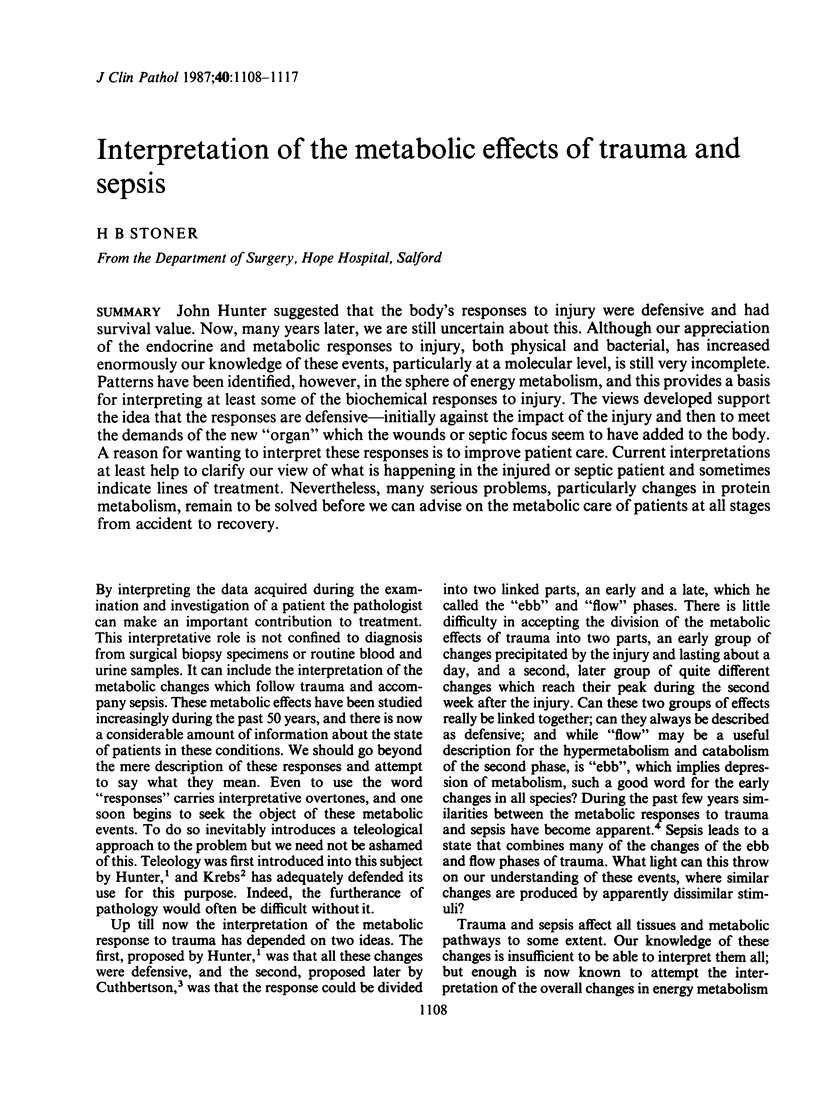
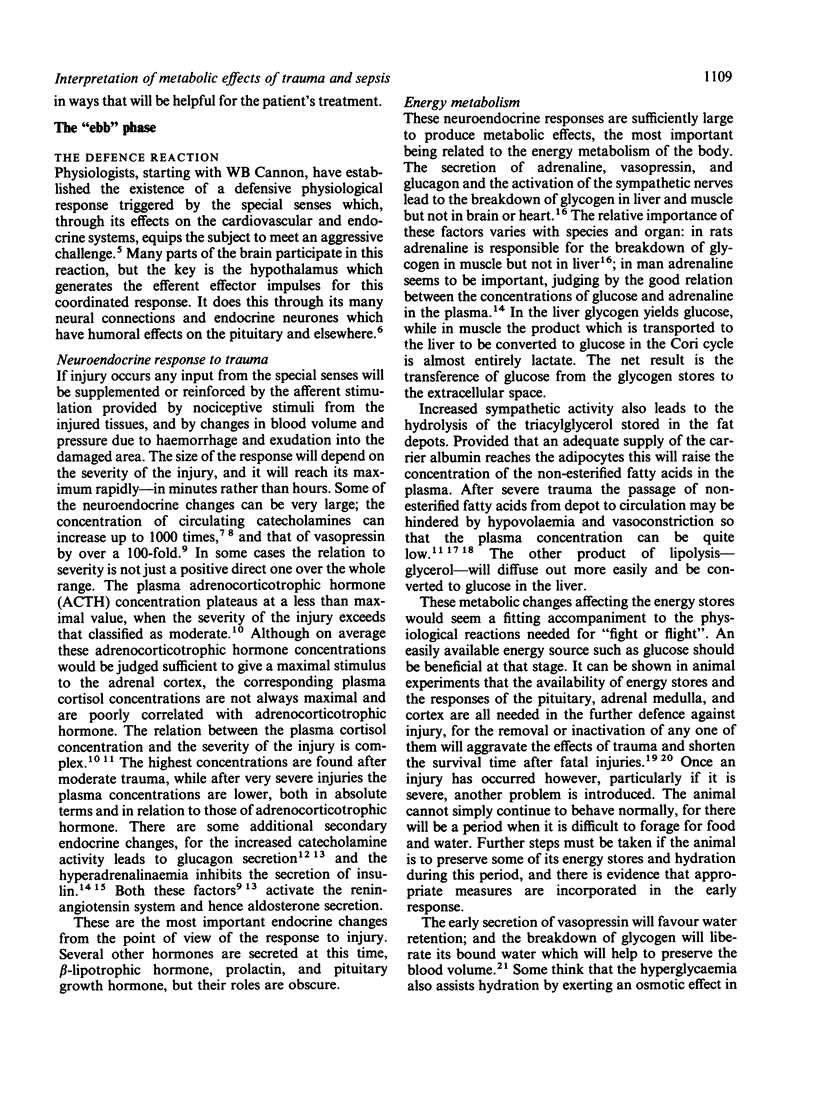
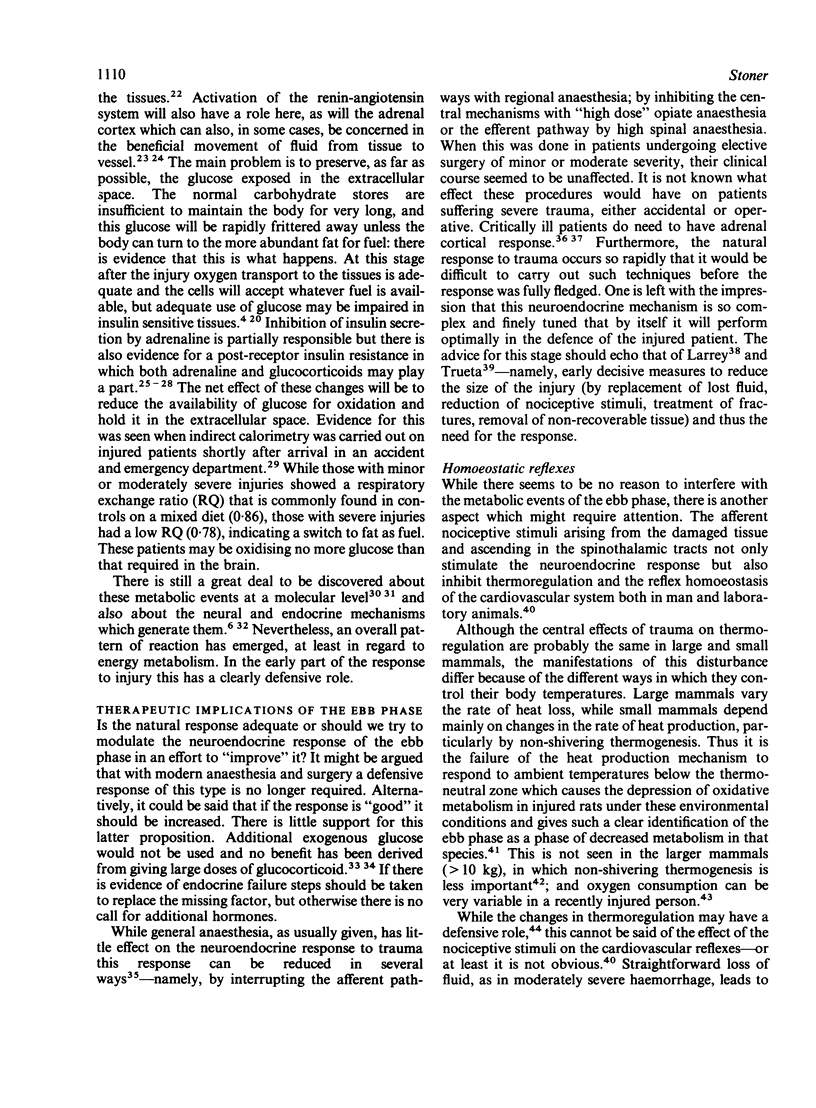
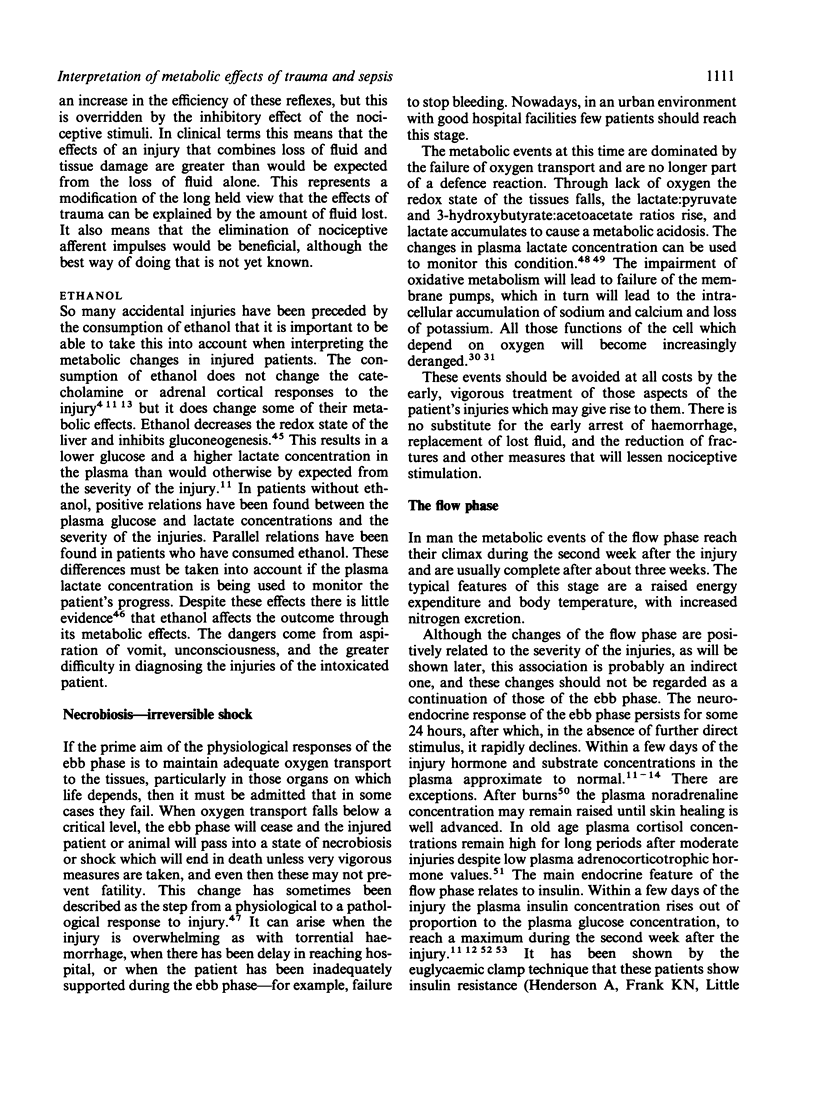
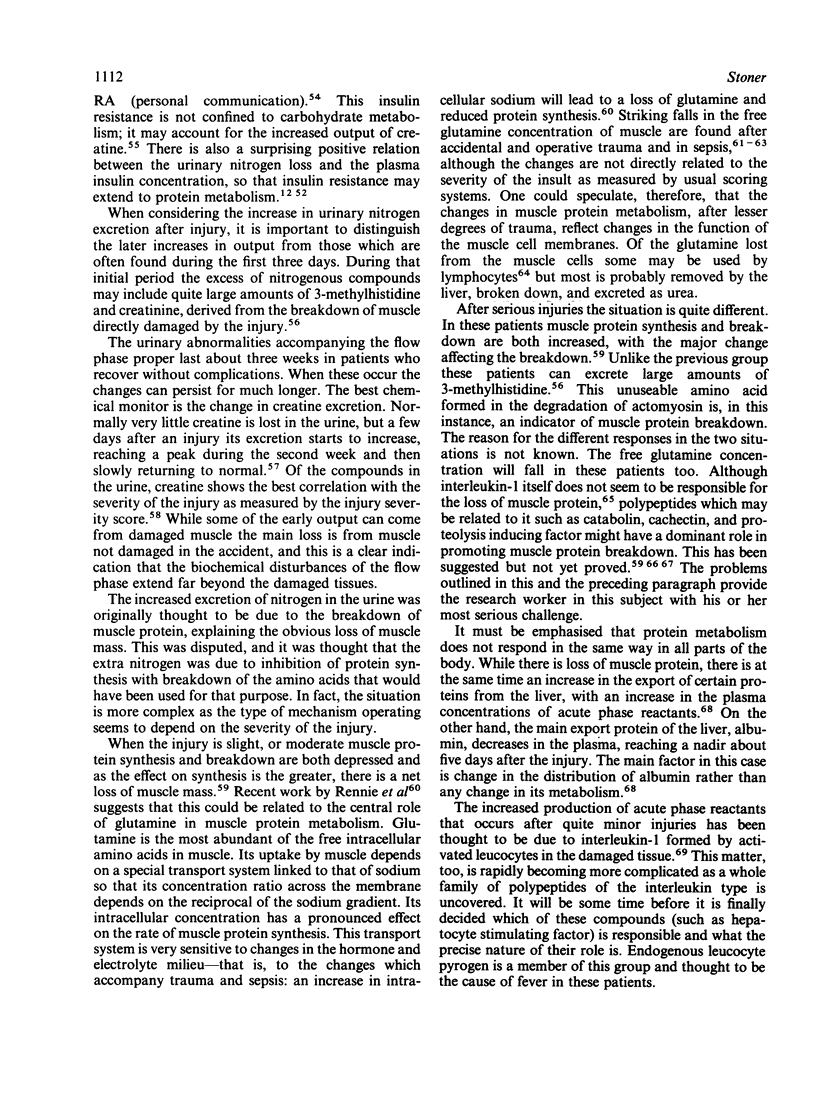

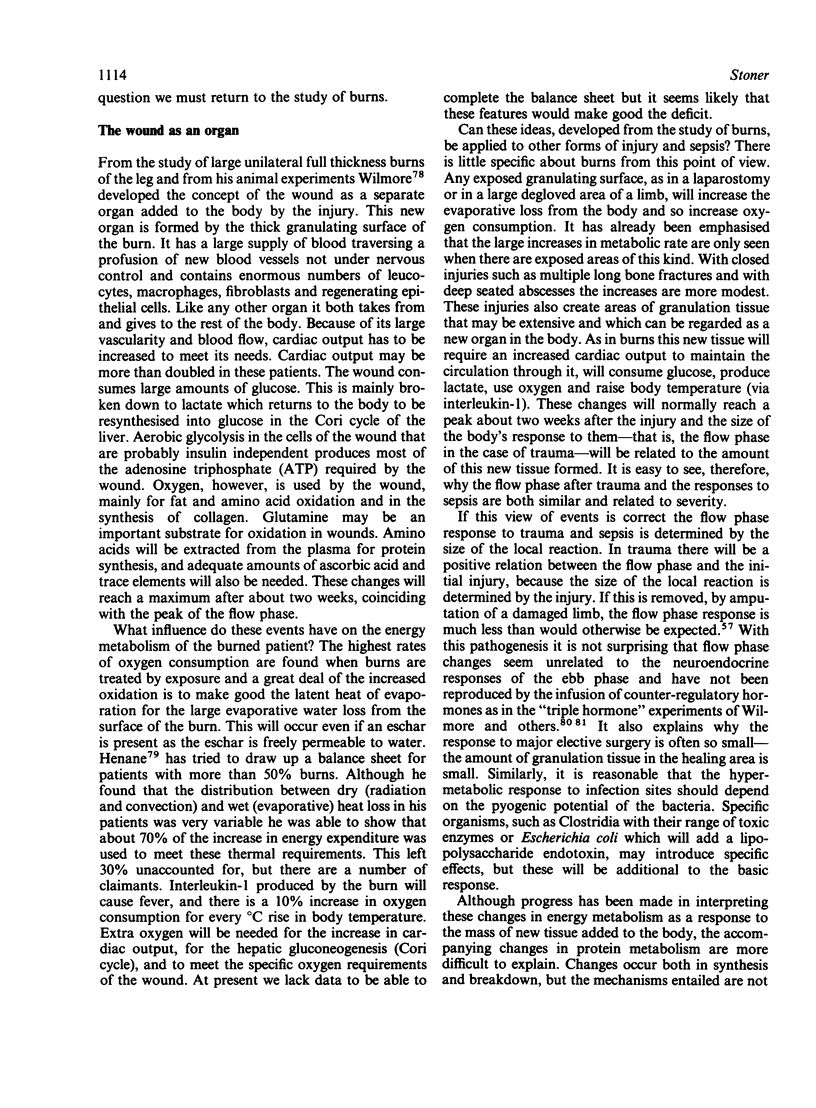
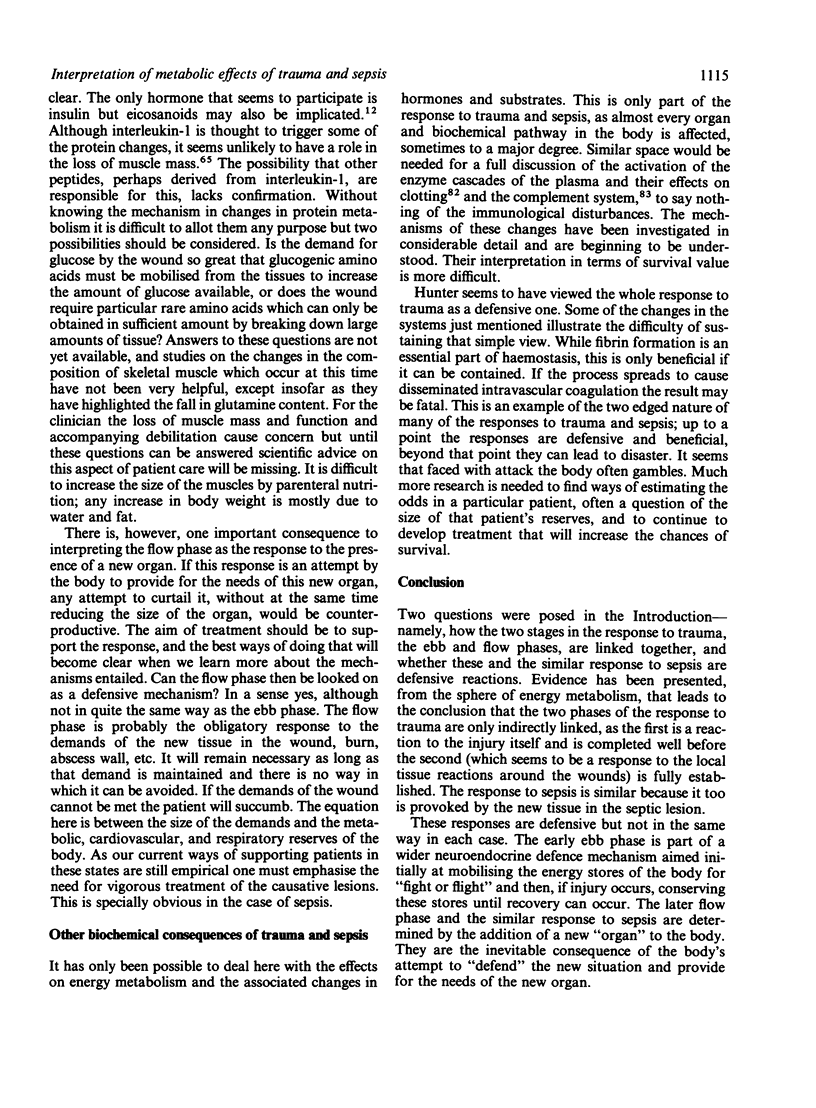
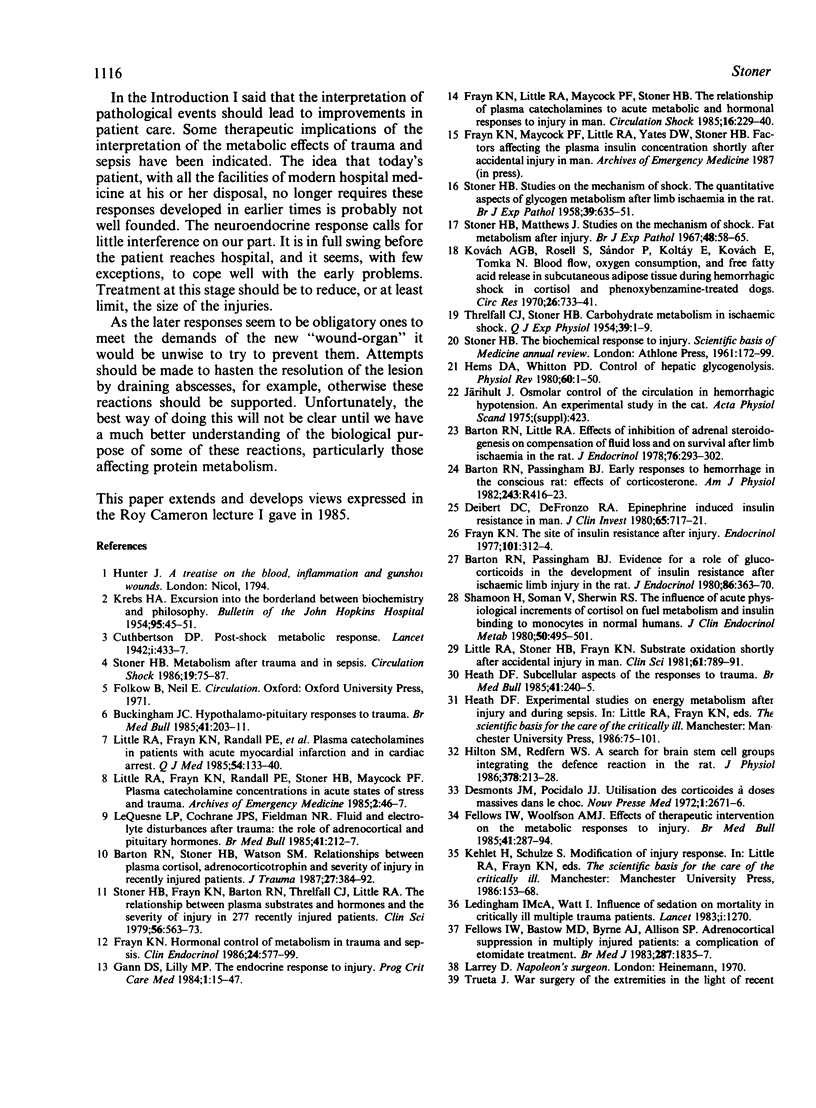
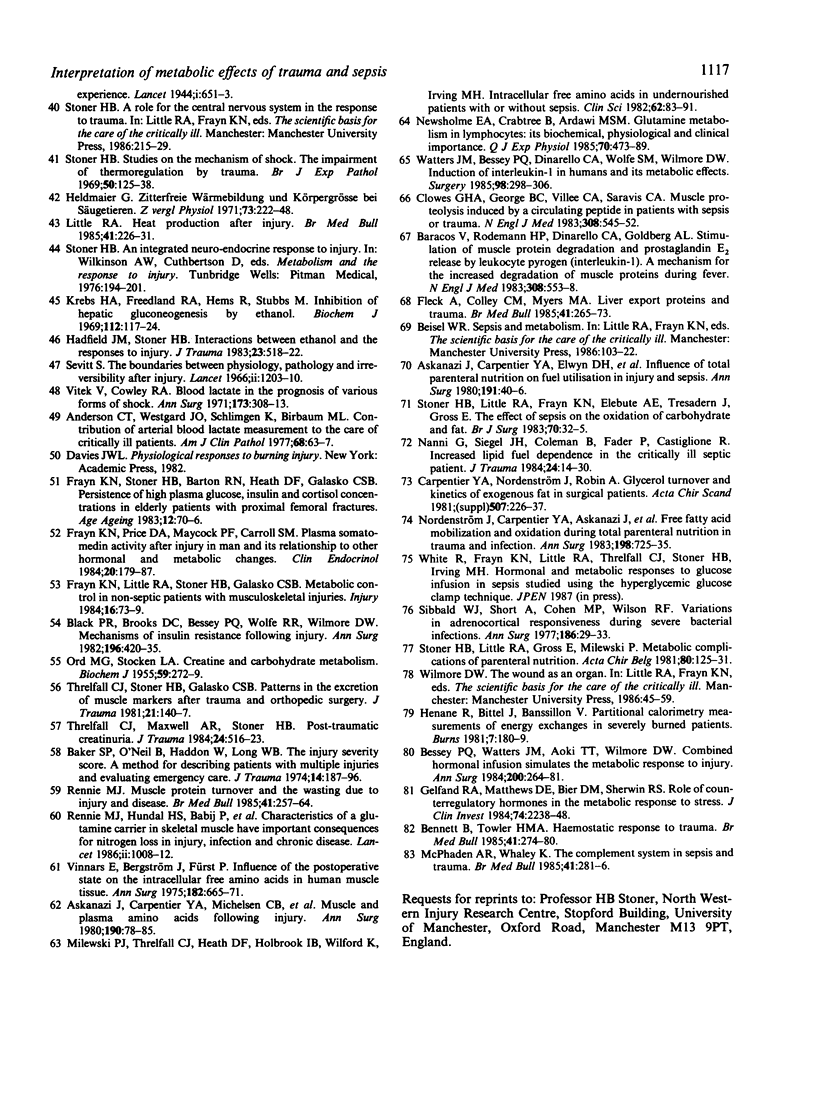
Selected References
These references are in PubMed. This may not be the complete list of references from this article.
- Anderson C. T., Jr, Westgard J. O., Schlimgen K., Birnbaum M. L. Contribution of arterial blood lactate measurement to the care of critically ill patients. Am J Clin Pathol. 1977 Jul;68(1):63–67. doi: 10.1093/ajcp/68.1.63. [DOI] [PubMed] [Google Scholar]
- Askanazi J., Carpentier Y. A., Elwyn D. H., Nordenström J., Jeevanandam M., Rosenbaum S. H., Gump F. E., Kinney J. M. Influence of total parenteral nutrition on fuel utilization in injury and sepsis. Ann Surg. 1980 Jan;191(1):40–46. doi: 10.1097/00000658-198001000-00008. [DOI] [PMC free article] [PubMed] [Google Scholar]
- Askanazi J., Carpentier Y. A., Michelsen C. B., Elwyn D. H., Furst P., Kantrowitz L. R., Gump F. E., Kinney J. M. Muscle and plasma amino acids following injury. Influence of intercurrent infection. Ann Surg. 1980 Jul;192(1):78–85. doi: 10.1097/00000658-198007000-00014. [DOI] [PMC free article] [PubMed] [Google Scholar]
- Baker S. P., O'Neill B., Haddon W., Jr, Long W. B. The injury severity score: a method for describing patients with multiple injuries and evaluating emergency care. J Trauma. 1974 Mar;14(3):187–196. [PubMed] [Google Scholar]
- Baracos V., Rodemann H. P., Dinarello C. A., Goldberg A. L. Stimulation of muscle protein degradation and prostaglandin E2 release by leukocytic pyrogen (interleukin-1). A mechanism for the increased degradation of muscle proteins during fever. N Engl J Med. 1983 Mar 10;308(10):553–558. doi: 10.1056/NEJM198303103081002. [DOI] [PubMed] [Google Scholar]
- Barton R. N., Little R. A. Effects of inhibition of adrenal steroidogenesis on compensation of fluid loss and on survivial after limb ischaemia in the rat. J Endocrinol. 1978 Feb;76(2):293–302. doi: 10.1677/joe.0.0760293. [DOI] [PubMed] [Google Scholar]
- Barton R. N., Passingham B. J. Early responses to hemorrhage in the conscious rat: effects of corticosterone. Am J Physiol. 1982 Sep;243(3):R416–R423. doi: 10.1152/ajpregu.1982.243.3.R416. [DOI] [PubMed] [Google Scholar]
- Barton R. N., Passingham B. J. Evidence for a role of glucocorticoids in the development of insulin resistance after ischaemic limb injury in the rat. J Endocrinol. 1980 Aug;86(2):363–370. doi: 10.1677/joe.0.0860363. [DOI] [PubMed] [Google Scholar]
- Barton R. N., Stoner H. B., Watson S. M. Relationships among plasma cortisol, adrenocorticotrophin, and severity of injury in recently injured patients. J Trauma. 1987 Apr;27(4):384–392. doi: 10.1097/00005373-198704000-00007. [DOI] [PubMed] [Google Scholar]
- Bennett B., Towler H. M. Haemostatic response to trauma. Br Med Bull. 1985 Jul;41(3):274–280. doi: 10.1093/oxfordjournals.bmb.a072062. [DOI] [PubMed] [Google Scholar]
- Bessey P. Q., Watters J. M., Aoki T. T., Wilmore D. W. Combined hormonal infusion simulates the metabolic response to injury. Ann Surg. 1984 Sep;200(3):264–281. doi: 10.1097/00000658-198409000-00004. [DOI] [PMC free article] [PubMed] [Google Scholar]
- Black P. R., Brooks D. C., Bessey P. Q., Wolfe R. R., Wilmore D. W. Mechanisms of insulin resistance following injury. Ann Surg. 1982 Oct;196(4):420–435. doi: 10.1097/00000658-198210000-00005. [DOI] [PMC free article] [PubMed] [Google Scholar]
- Buckingham J. C. Hypothalamo-pituitary responses to trauma. Br Med Bull. 1985 Jul;41(3):203–211. doi: 10.1093/oxfordjournals.bmb.a072052. [DOI] [PubMed] [Google Scholar]
- Clowes G. H., Jr, George B. C., Villee C. A., Jr, Saravis C. A. Muscle proteolysis induced by a circulating peptide in patients with sepsis or trauma. N Engl J Med. 1983 Mar 10;308(10):545–552. doi: 10.1056/NEJM198303103081001. [DOI] [PubMed] [Google Scholar]
- Deibert D. C., DeFronzo R. A. Epinephrine-induced insulin resistance in man. J Clin Invest. 1980 Mar;65(3):717–721. doi: 10.1172/JCI109718. [DOI] [PMC free article] [PubMed] [Google Scholar]
- Desmonts J. M., Pocidalo J. J. Utilisation des corticoïdes à doses massives dans le chox. Bases expérimentales et étude critique. Nouv Presse Med. 1972 Nov 11;1(40):2671–2676. [PubMed] [Google Scholar]
- Fellows I. W., Bastow M. D., Byrne A. J., Allison S. P. Adrenocortical suppression in multiply injured patients: a complication of etomidate treatment. Br Med J (Clin Res Ed) 1983 Dec 17;287(6408):1835–1837. doi: 10.1136/bmj.287.6408.1835. [DOI] [PMC free article] [PubMed] [Google Scholar]
- Fellows I. W., Woolfson A. M. Effects of therapeutic intervention on the metabolic responses to injury. Br Med Bull. 1985 Jul;41(3):287–294. doi: 10.1093/oxfordjournals.bmb.a072064. [DOI] [PubMed] [Google Scholar]
- Fleck A., Colley C. M., Myers M. A. Liver export proteins and trauma. Br Med Bull. 1985 Jul;41(3):265–273. doi: 10.1093/oxfordjournals.bmb.a072061. [DOI] [PubMed] [Google Scholar]
- Frayn K. N. Hormonal control of metabolism in trauma and sepsis. Clin Endocrinol (Oxf) 1986 May;24(5):577–599. doi: 10.1111/j.1365-2265.1986.tb03288.x. [DOI] [PubMed] [Google Scholar]
- Frayn K. N., Little R. A., Maycock P. F., Stoner H. B. The relationship of plasma catecholamines to acute metabolic and hormonal responses to injury in man. Circ Shock. 1985;16(3):229–240. [PubMed] [Google Scholar]
- Frayn K. N., Little R. A., Stoner H. B., Galasko C. S. Metabolic control in non-septic patients with musculoskeletal injuries. Injury. 1984 Sep;16(2):73–79. doi: 10.1016/s0020-1383(84)80001-7. [DOI] [PubMed] [Google Scholar]
- Frayn K. N., Price D. A., Maycock P. F., Carroll S. M. Plasma somatomedin activity after injury in man and its relationship to other hormonal and metabolic changes. Clin Endocrinol (Oxf) 1984 Feb;20(2):179–187. doi: 10.1111/j.1365-2265.1984.tb00073.x. [DOI] [PubMed] [Google Scholar]
- Frayn K. N., Stoner H. B., Barton R. N., Heath D. F., Galasko C. S. Persistence of high plasma glucose, insulin and cortisol concentrations in elderly patients with proximal femoral fractures. Age Ageing. 1983 Feb;12(1):70–76. doi: 10.1093/ageing/12.1.70. [DOI] [PubMed] [Google Scholar]
- Frayn K. N. The site of insulin resistance after injury. Endocrinology. 1977 Jul;101(1):312–314. doi: 10.1210/endo-101-1-312. [DOI] [PubMed] [Google Scholar]
- Gelfand R. A., Matthews D. E., Bier D. M., Sherwin R. S. Role of counterregulatory hormones in the catabolic response to stress. J Clin Invest. 1984 Dec;74(6):2238–2248. doi: 10.1172/JCI111650. [DOI] [PMC free article] [PubMed] [Google Scholar]
- Hadfield J. M., Stoner H. B. Interactions between ethanol and the responses to injury. J Trauma. 1983 Jun;23(6):518–522. doi: 10.1097/00005373-198306000-00013. [DOI] [PubMed] [Google Scholar]
- Heath D. F. Subcellular aspects of the response to trauma. Br Med Bull. 1985 Jul;41(3):240–245. doi: 10.1093/oxfordjournals.bmb.a072057. [DOI] [PubMed] [Google Scholar]
- Hems D. A., Whitton P. D. Control of hepatic glycogenolysis. Physiol Rev. 1980 Jan;60(1):1–50. doi: 10.1152/physrev.1980.60.1.1. [DOI] [PubMed] [Google Scholar]
- Hilton S. M., Redfern W. S. A search for brain stem cell groups integrating the defence reaction in the rat. J Physiol. 1986 Sep;378:213–228. doi: 10.1113/jphysiol.1986.sp016215. [DOI] [PMC free article] [PubMed] [Google Scholar]
- Kovách A. G., Rosell S., Sándor P., Koltay E., Kovách E., Tomka N. Blood flow, oxygen consumption, and free fatty acid release in subcutaneous adipose tissue during hemorrhagic shock in control and phenoxybenzamine-treated dogs. Circ Res. 1970 Jun;26(6):733–741. doi: 10.1161/01.res.26.6.733. [DOI] [PubMed] [Google Scholar]
- Le Quesne L. P., Cochrane J. P., Fieldman N. R. Fluid and electrolyte disturbances after trauma: the role of adrenocortical and pituitary hormones. Br Med Bull. 1985 Jul;41(3):212–217. doi: 10.1093/oxfordjournals.bmb.a072053. [DOI] [PubMed] [Google Scholar]
- Ledingham I. M., Watt I. Influence of sedation on mortality in critically ill multiple trauma patients. Lancet. 1983 Jun 4;1(8336):1270–1270. doi: 10.1016/s0140-6736(83)92712-5. [DOI] [PubMed] [Google Scholar]
- Little R. A., Frayn K. N., Randall P. E., Stoner H. B., Maycock P. F. Plasma catecholamine concentrations in acute states of stress and trauma. Arch Emerg Med. 1985 Mar;2(1):46–47. doi: 10.1136/emj.2.1.46. [DOI] [PMC free article] [PubMed] [Google Scholar]
- Little R. A., Frayn K. N., Randall P. E., Stoner H. B., Yates D. W., Laing G. S., Kumar S., Banks J. M. Plasma catecholamines in patients with acute myocardial infarction and in cardiac arrest. Q J Med. 1985 Feb;54(214):133–140. [PubMed] [Google Scholar]
- Little R. A. Heat production after injury. Br Med Bull. 1985 Jul;41(3):226–231. doi: 10.1093/oxfordjournals.bmb.a072055. [DOI] [PubMed] [Google Scholar]
- Little R. A., Stoner H. B., Frayn K. N. Substrate oxidation shortly after accidental injury in man. Clin Sci (Lond) 1981 Dec;61(6):789–791. doi: 10.1042/cs0610789. [DOI] [PubMed] [Google Scholar]
- McPhaden A. R., Whaley K. The complement system in sepsis and trauma. Br Med Bull. 1985 Jul;41(3):281–286. doi: 10.1093/oxfordjournals.bmb.a072063. [DOI] [PubMed] [Google Scholar]
- Milewski P. J., Threlfall C. J., Heath D. F., Holbrook I. B., Wilford K., Irving M. H. Intracellular free amino acids in undernourished patients with or without sepsis. Clin Sci (Lond) 1982 Jan;62(1):83–91. doi: 10.1042/cs0620083. [DOI] [PubMed] [Google Scholar]
- Nanni G., Siegel J. H., Coleman B., Fader P., Castiglione R. Increased lipid fuel dependence in the critically ill septic patient. J Trauma. 1984 Jan;24(1):14–30. doi: 10.1097/00005373-198401000-00003. [DOI] [PubMed] [Google Scholar]
- Newsholme E. A., Crabtree B., Ardawi M. S. Glutamine metabolism in lymphocytes: its biochemical, physiological and clinical importance. Q J Exp Physiol. 1985 Oct;70(4):473–489. doi: 10.1113/expphysiol.1985.sp002935. [DOI] [PubMed] [Google Scholar]
- Nordenström J., Carpentier Y. A., Askanazi J., Robin A. P., Elwyn D. H., Hensle T. W., Kinney J. M. Free fatty acid mobilization and oxidation during total parenteral nutrition in trauma and infection. Ann Surg. 1983 Dec;198(6):725–735. doi: 10.1097/00000658-198312000-00011. [DOI] [PMC free article] [PubMed] [Google Scholar]
- ORD M. G., STOCKEN L. A. Creatine and carbohydrate metabolism. Biochem J. 1955 Feb;59(2):272–279. doi: 10.1042/bj0590272. [DOI] [PMC free article] [PubMed] [Google Scholar]
- Rennie M. J., Hundal H. S., Babij P., MacLennan P., Taylor P. M., Watt P. W., Jepson M. M., Millward D. J. Characteristics of a glutamine carrier in skeletal muscle have important consequences for nitrogen loss in injury, infection, and chronic disease. Lancet. 1986 Nov 1;2(8514):1008–1012. doi: 10.1016/s0140-6736(86)92617-6. [DOI] [PubMed] [Google Scholar]
- Rennie M. J. Muscle protein turnover and the wasting due to injury and disease. Br Med Bull. 1985 Jul;41(3):257–264. doi: 10.1093/oxfordjournals.bmb.a072060. [DOI] [PubMed] [Google Scholar]
- STONER H. B. Studies on the mechanism of shock; the quantitative aspects of glycogen metabolism after limb ischaemia in the rat. Br J Exp Pathol. 1958 Dec;39(6):635–651. [PMC free article] [PubMed] [Google Scholar]
- Sevitt S. The boundaries between physiology, pathology, and irreversibility after injury. Lancet. 1966 Dec 3;2(7475):1203–1210. doi: 10.1016/s0140-6736(66)92299-9. [DOI] [PubMed] [Google Scholar]
- Shamoon H., Soman V., Sherwin R. S. The influence of acute physiological increments of cortisol on fuel metabolism and insulin binding to monocytes in normal humans. J Clin Endocrinol Metab. 1980 Mar;50(3):495–501. doi: 10.1210/jcem-50-3-495. [DOI] [PubMed] [Google Scholar]
- Sibbald W. J., Short A., Cohen M. P., Wilson R. F. Variations in adrenocortical responsiveness during severe bacterial infections. Unrecognized adrenocortical insufficiency in severe bacterial infections. Ann Surg. 1977 Jul;186(1):29–33. doi: 10.1097/00000658-197707000-00005. [DOI] [PMC free article] [PubMed] [Google Scholar]
- Stoner H. B., Frayn K. N., Barton R. N., Threlfall C. J., Little R. A. The relationships between plasma substrates and hormones and the severity of injury in 277 recently injured patients. Clin Sci (Lond) 1979 Jan;56(6):563–573. doi: 10.1042/cs0560563. [DOI] [PubMed] [Google Scholar]
- Stoner H. B., Little R. A., Frayn K. N., Elebute A. E., Tresadern J., Gross E. The effect of sepsis on the oxidation of carbohydrate and fat. Br J Surg. 1983 Jan;70(1):32–35. doi: 10.1002/bjs.1800700113. [DOI] [PubMed] [Google Scholar]
- Stoner H. B., Little R. A., Gross E., Milewski P. Metabolic complications of parenteral nutrition. Acta Chir Belg. 1981 Mar-Jun;80(2-3):125–131. [PubMed] [Google Scholar]
- Stoner H. B., Matthews J. Studies on the mechanism of shock. Fat mobilization after injury. Br J Exp Pathol. 1967 Feb;48(1):58–65. [PMC free article] [PubMed] [Google Scholar]
- Stoner H. B. Metabolism after trauma and in sepsis. Circ Shock. 1986;19(1):75–87. [PubMed] [Google Scholar]
- Stoner H. B. Studies on the mechanism of shock. The impariment of thermoregulation by trauma. Br J Exp Pathol. 1969 Apr;50(2):125–138. [PMC free article] [PubMed] [Google Scholar]
- THRELFALL C. J., STONER H. B. Carbohydrate metabolism in ischaemic shock. Q J Exp Physiol Cogn Med Sci. 1954;39(1):1–9. doi: 10.1113/expphysiol.1954.sp001043. [DOI] [PubMed] [Google Scholar]
- Threlfall C. J., Maxwell A. R., Stoner H. B. Post-traumatic creatinuria. J Trauma. 1984 Jun;24(6):516–523. doi: 10.1097/00005373-198406000-00009. [DOI] [PubMed] [Google Scholar]
- Threlfall C. J., Stoner H. B., Galasko C. S. Patterns in the excretion of muscle markers after trauma and orthopedic surgery. J Trauma. 1981 Feb;21(2):140–147. doi: 10.1097/00005373-198102000-00008. [DOI] [PubMed] [Google Scholar]
- Vinnars E., Bergstöm J., Fürst P. Influence of the postoperative state on the intracellular free amino acids in human muscle tissue. Ann Surg. 1975 Dec;182(6):665–671. doi: 10.1097/00000658-197512000-00001. [DOI] [PMC free article] [PubMed] [Google Scholar]
- Vitek V., Cowley R. A. Blood lactate in the prognosis of various forms of shock. Ann Surg. 1971 Feb;173(2):308–313. doi: 10.1097/00000658-197102000-00021. [DOI] [PMC free article] [PubMed] [Google Scholar]
- Watters J. M., Bessey P. Q., Dinarello C. A., Wolff S. M., Wilmore D. W. The induction of interleukin-1 in humans and its metabolic effects. Surgery. 1985 Aug;98(2):298–306. [PubMed] [Google Scholar]
- Weidemann M. J., Hems D. A., Krebs H. A. Effects of added nucleotides on renal carbohydrate metabolism. Biochem J. 1969 Oct;115(1):1–10. doi: 10.1042/bj1150001. [DOI] [PMC free article] [PubMed] [Google Scholar]


